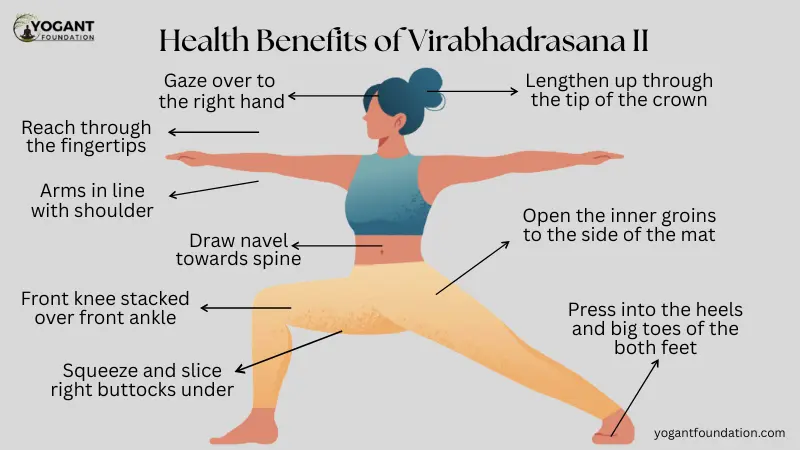Virabhadrasana II (Warrior II Pose)
Warrior Pose II, or Virabhadrasana II is the most fundamental standing pose as part of yoga. The asana shows strength, balance, and focus. It represents the powerful part of Shiva called Virabhadra. Adding this asana to your daily routine will greatly improve your physical, mental, and spiritual health.
In this blog, we will explore:
- The meaning of Virabhadrasana II
- Step-by-step instructions
- Benefits of the pose
- Precautions and contraindications
- Tips for beginners
What is Virabhadrasana II?
The phrase “Virabhadrasana” comes from a mix of Sanskrit components:
Vira – which means hero, warrior
Bhadra is a symbol of friend or a favorable
Asana is a reference to a posture
Virabhadrasana II represents the courageous spirit that is within each one of us. The pose is a symbol of courage as well as inner strength and the ability to stay focused in the face of life’s difficulties.
This pose is often practiced in Hatha Yoga and Ashtanga Yoga. Commonly included in yoga retreats and daily routines.
How to Do Virabhadrasana II (Step-by-Step Guide)
To do Warrior Pose II safely, follow these simple steps:
1. Start with Tadasana (Mountain Pose). Stand straight with your feet together and your arms at your sides.
2. Increase Your Stance by Stepping the distance between your feet by 3.5 to four feet.
3. Make One Foot Rotate, turn your right foot to the left by 90 degrees, while turning your left foot to the side.
4. Make sure you align your Heels Remember to ensure that the right side of your foot in alignment with the arch of your left foot.
5. Then raise your arms – lift both arms to ensure they’re aligned with the ground with your palms facing downwards.
6. Bend Your Front Knee Your right knee should be lowered directly over your ankle. This creates an angle of right.
7. Check Your Back Hand Focus your attention toward your left hand.
8. Keep the stance – Maintain the stance for about 20-30 minutes while inhaling slowly.
9. Switch Sides – Alternate legs, and then perform the pose repeatedly.
Key Alignment Tips
Maintain your body upright and not bending either way or the other.
Spread your weight evenly across each leg.
Be sure that your knee isn’t bent over the ankle.
Make sure your back leg is firm and long.
Benefits of Virabhadrasana II
Constantly engaging in Warrior II offers numerous physical and mental benefits:
1. Strengthens the Legs
The lunge posture efficiently targets the thighs ankles, calves as well as glutes. An ideal workout for toning the lower part of your body.
2. Increases Stamina and Endurance
The practice of this posture will increase your endurance, balance and the core stabilization.
3. Expands the Hips and Chest
Warrior II promotes flexibility and improved posture through stretching of the groins, hip joints and the chest muscles.
4. Enhances Focus
Concentrating your attention on your hand helps to cultivate concentration as well as mental clarity and concentration.
5. Alleviates Back Pain
The posture strengthens the spine, and may ease some back pain. This is especially beneficial when you spend many periods of in a seated position.
6. Boosts Circulation and Vitality
Virabhadrasana II helps the respiratory and circulatory systems. It increases oxygen and blood flow throughout the body.
Precautions and Contraindications
Even though Warrior II is typically considered an appropriate pose for beginners, take these considerations into mind:
If you’ve sustained injuries to your knees, or hips, you should modify your pose or ask for advice from the yoga teacher.
Anyone with high blood pressure must be mindful and restrict the time they spend in the exercise.
For those with neck issues, keep an upright head posture instead of bending it in order see over your fingers.
In pregnancy it is possible to performed safely during the first trimester, with modifications. However, it’s crucial to consult your health doctor prior to doing it.
Modifications for Beginners
If you’re new in yoga, these suggestions for beginners:
Set yourself up against an object that can help you stay in a stable position and provide support.
Reduce your posture – bring your feet closer for a more efficient practice.
Include blocks yoga blocks under your thighs to provide additional assistance.
When You Practice Virabhadrasana II
Practice it during your morning yoga routine to energize your day.
It can be part of a Sun Salutation variation or standing sequence.
Include it in Hatha Yoga or Ashtanga Yoga practices.
Spiritual Significance of the Warrior Pose
In yoga, Virabhadrasana II represents the spiritual warrior. This warrior battles against self-doubt, madness, and fear. In this position, you serve as a reminder of being solid, steady and empathetic, even during times of difficulty.
Conclusion
Virabhadrasana II goes beyond being just the physical pose It is a powerful symbol of inner courage. Practicing this regularly will help you build physical strength and endurance. Improve your concentration, self-confidence, and mental strength.
No matter your experience level, adding Warrior II to your daily routine can greatly improve your yoga practice. It can also strengthen the connection between your brain and body.
Frequently Asked Questions
Q1. How long should I hold Virabhadrasana II?
A: Start with 20–30 seconds and increase gradually as your strength improves.
Q2. Can beginners do Warrior II Pose?
A: Yes, with proper alignment and modifications, beginners can safely practice this pose.
Q3. Is Virabhadrasana II part of Sun Salutations?
A: It is not in the traditional Sun Salutation, but many people include it in modern flow sequences.
Read Blog: How to Do Warrior A (Virabhadrasana I) with Benefits, Steps




Pingback: Warrior 3 Pose: How to Practice Virabhadrasana III